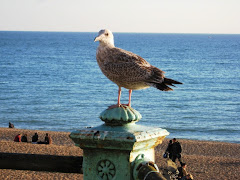
My partner and I recently went to Limoges (in France) for the wedding of some good friends of ours from London. When we got the invitation, one of the first questions was (of course) how to get there. We don't have a car, so driving was out: apart from the cost of car hire, the thought of driving 800-odd miles on a week-end - and the August Bank Holiday in the UK to boot - was just too much.
That left public transport. A quick bit of research showed that the options were to fly with either Ryanair from Stansted, bmi from Southampton, or take the train all the way.
A check on the dates proved that bmi was going to be too expensive, so that ruled them out. Ryanair started well enough with the low initial fare, but of course - as anyone who has used their website will know - the add-ons creep up pretty quickly. Because we would have to take check-in luggage (I suppose you could get a man's suit in hand luggage, but you really don't the French laughing at the sartorial
faux pas of wearing anything so crumpled), we would have to pay the fees for checking in the luggage and, if you do that, no-one in the party can check in on-line, so adding the cost of boarding passes for each person for each leg of the flight. Add in taxes and the booking fee, and the whole thing rapidly soared over the £200 mark. And, of course, for us there's the cost of getting to Stansted to add in, not to mention the horrible thought of going anywhere near Stansted Airport on the Bank Holiday.
So we went for the rail option: £79 returns on Eurostar, and £40 return on the French leg from Paris to Limoges (astonishing value for a 600-mile round trip on SNCF). It worked out about the same as Ryanair on cost but, although although it was longer, the trains are pretty comfy and you get to watch the scenery flash by. And 7 hours actually compares favourably with air by the time you add in getting to the airport and allowing for check-in time.
And the result? Well, the journey there was bliss. We had an early start - checking in at St Pancras at 6.45am - but there were no queues, the new terminal seems to run very smoothly, and we slept all the way to Paris. The Gare du Nord is not my favourite corner of Paris, but we still reached Austerlitz station in less than half an hour on the metro. From there, the
Corail Teoz service - TGVs don't operate this route - was a lesson in civilized travel. Bags of leg room, bags of luggage space, reclining seats in Second Class, and perfect conditions for yet more sleep. Arrival at the very impressive Gare de Benedictins
(above) was the perfect end to the journey.
The return leg was pretty good as well, except Gare du Nord Eurostar terminal needs some pretty major expansion to cope with Bank Holiday crowds. Still, all in all it made for a very civilized week-end.
Oh, and the wedding went pretty well, too...
 The Church of St Michael and All Angels, Victoria Road, by Bodley and Burgess, contains notable pre-Raphaelite stained glass.
The Church of St Michael and All Angels, Victoria Road, by Bodley and Burgess, contains notable pre-Raphaelite stained glass.










+004.JPG)











